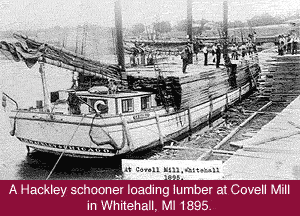|
Throughout this time period, Charles gained substantial knowledge of the working of a mill and the business of lumbering. He, too, perceived the expanding market possibilities with the westward expansion of the United States. He realized that Michigan lumber would be an important part of this expansion.
Beginning at this time, Charles started purchasing many other mills, either as partner or as the outright owner. In 1874, James McGordon bought out Charles father share in the Wing mill and the new firm of Hackley and McGordon was formed. The same year, a new mill replaced the old Hackley and Sons mill which had been dismantled. The new mill cost $85,000.00.
The Hackley and McGordon mill burned and was not rebuilt. James McGordon purchased a share in the firm of Hackley and Son and the firm of C.H. Hackley and Company was created. After the death of Charles brother Edwin, Thomas Hume bought into the company. Mr. Hume had worked for Charles as a bookkeeper prior to this purchase. This was the beginning of the Hackley and Hume Company, which became known to lumbermen in Michigan and throughout the United States. The two men continued as partners until Charles death twenty nine years later.
The firm of Hackley and Hume was one of the largest firms, not only in Michigan , but in the entire country. The firm cut an average of 30,000,000 feet of lumber each year, as well as 8,000,000 pieces of lath. It was not until the last stand of pine was cut in 1894 that the firm ceased operations.
Beginning in the late 1880s, the forests of Michigan were nearly gone. There were no more trees to be cut. Muskegon, with a population of 24,000, depended entirely upon the lumber industry and the forty-seven sawmills around Muskegon Lake.
Further, in 1891, a fire swept Muskegon, destroying the principal business district. Many mill owners did not rebuild after a fire and some were accused of arson. Then, two years later, a financial panic swept the United States, further depressing Muskegons economy. Thousands of homes were empty, hundreds were taken over by the state for non-payment of taxes. Many people felt helpless.
 As early as 1879, Charles and other lumber mill owners and community leaders saw that urban revitalization was necessary. Support was given to new lumber related businesses: The Temple Manufacturing Company made curtain rollers starting that year. The lumbermen financed the Wood Package and Basket Company and a new furniture factory which opened in 1884. By 1896, only three mills remained in Muskegon. The lumber barons and other community leaders who worked to attract new business called themselves the Muskegon Board of Trade. By 1893, the group became the Chamber of Commerce. They also drew to the area the Chase Piano Company, Amazon Knitting Company, Continental Motors and Central Paper Company, as well as many other businesses. As early as 1879, Charles and other lumber mill owners and community leaders saw that urban revitalization was necessary. Support was given to new lumber related businesses: The Temple Manufacturing Company made curtain rollers starting that year. The lumbermen financed the Wood Package and Basket Company and a new furniture factory which opened in 1884. By 1896, only three mills remained in Muskegon. The lumber barons and other community leaders who worked to attract new business called themselves the Muskegon Board of Trade. By 1893, the group became the Chamber of Commerce. They also drew to the area the Chase Piano Company, Amazon Knitting Company, Continental Motors and Central Paper Company, as well as many other businesses.
In addition, the mill owners were active in politics. From the time of the first election of a mayor of Muskegon in 1870 to the year 1889, nine of the twenty mayors were lumbermen or associated with the lumber industry. In fact, Charles ran unsuccessfully for mayor in 1873 and 1877, but he did serve as alderman and city treasurer, as well as on the school board.
In 1877, Charles was first elected to the Muskegon school board. In 1892 he was made president of the board, a position he held until his death.Further political involvement occurred when he was a state delegate to the National Republican convention in Minneapolis in 1892, and again, he was the delegate to the 1896 St. Louis convention.
|




 As early as 1879, Charles and other lumber mill owners and community leaders saw that urban revitalization was necessary. Support was given to new lumber related businesses: The Temple Manufacturing Company made curtain rollers starting that year. The lumbermen financed the Wood Package and Basket Company and a new furniture factory which opened in 1884. By 1896, only three mills remained in Muskegon. The lumber barons and other community leaders who worked to attract new business called themselves the Muskegon Board of Trade. By 1893, the group became the Chamber of Commerce. They also drew to the area the Chase Piano Company, Amazon Knitting Company, Continental Motors and Central Paper Company, as well as many other businesses.
As early as 1879, Charles and other lumber mill owners and community leaders saw that urban revitalization was necessary. Support was given to new lumber related businesses: The Temple Manufacturing Company made curtain rollers starting that year. The lumbermen financed the Wood Package and Basket Company and a new furniture factory which opened in 1884. By 1896, only three mills remained in Muskegon. The lumber barons and other community leaders who worked to attract new business called themselves the Muskegon Board of Trade. By 1893, the group became the Chamber of Commerce. They also drew to the area the Chase Piano Company, Amazon Knitting Company, Continental Motors and Central Paper Company, as well as many other businesses.